Photo
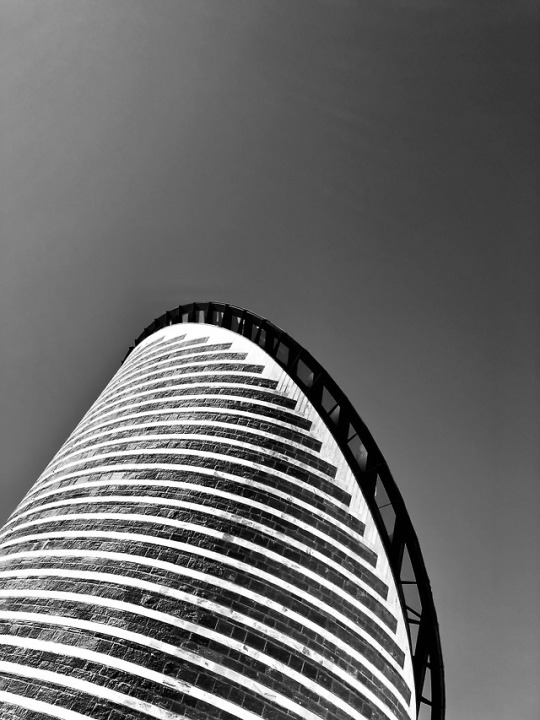

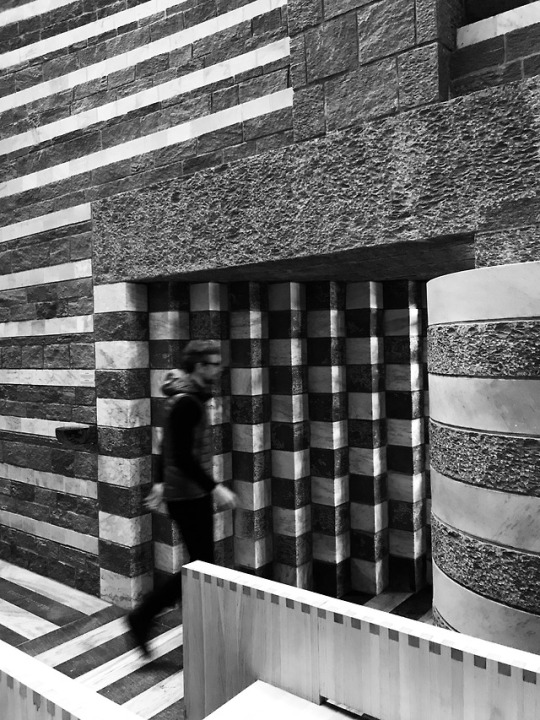
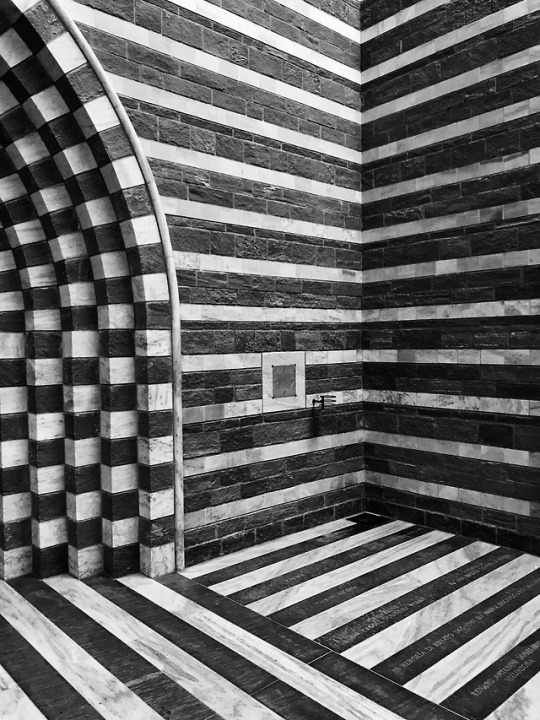
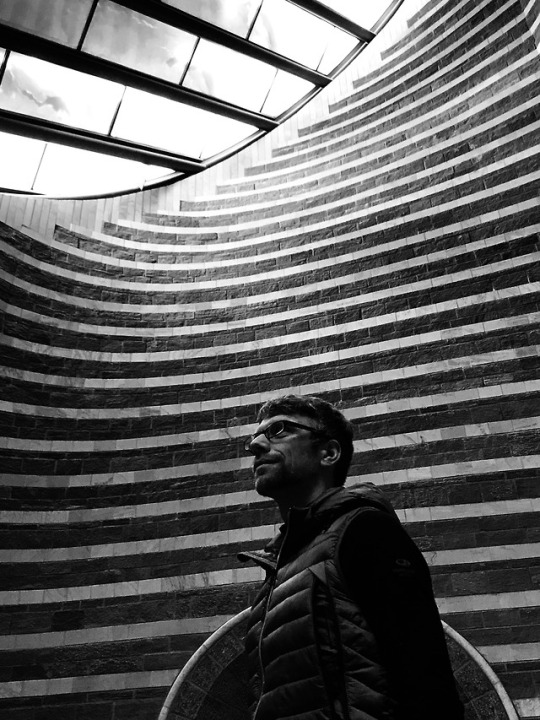

Botta at the far end Chiesa di San Giovanni Battista
I don’t know what draws us to modern sacral architecture in remote places (thinking back on our trip to Chapelle Notre-Dame-du-Haut), but they seem to be of the few buildings that actually enhance the quiet landscape rather than compromise it. They are like singular beacons of human existence in a sea of wood and stone, however dramatic that may sound. This can definitely be said of the Chiesa di San Giovanni Battista in the small village of Mogno. Nestled at the very end of the Valle Maggia, in this very remote corner of Switzerland, Mario Botta has left his mark in a way that only he can. His signature, stripes, are only a detail of this extraordinary and yet unassuming bit of architecture.

His version of a mountain church has a clear shape: a solid stone cylinder hammered into the ground and chopped off at an angle. As such, it looks incredibly resistent against the forces of nature. The intention behind the shape becomes clear when one learns that the church’s predecessor was swept away in an avalanche. Indeed, when visiting the church in winter one may find it difficult to access (we tested that).
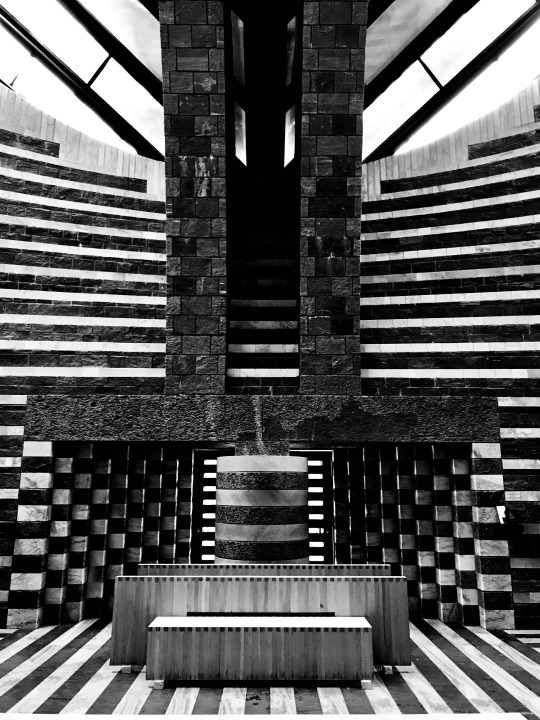
The simple shape of the building is enriched by the geometric pattern formed by black and white stone, which beautifully connects the the interiors with the exteriors. A particular highlight of the interior is the checkerboard-patterned arch behind the altar. The inside is bright due to the natural light coming in through the skylight. Otherwise, there is little distraction from the pure stone shapes and patterns. Furnished with a few wooden benches, the space is ideal to stop, meditate, pray, or let your thoughts wander.
#Mario Botta#Valle Maggia#Chiesa di San Giovanni Battista di Mogno#Mogno#San Giovanni Battista#Chiesa#Kirche#Église#Val de Maggia#Ticino#Tessin#Maggiatal#Stripes#Finn and Grey#Anthony and Titus#Suisse#Svizzera#Svizra#Schweiz#Switzerland#Architecture
2 notes
·
View notes
Photo


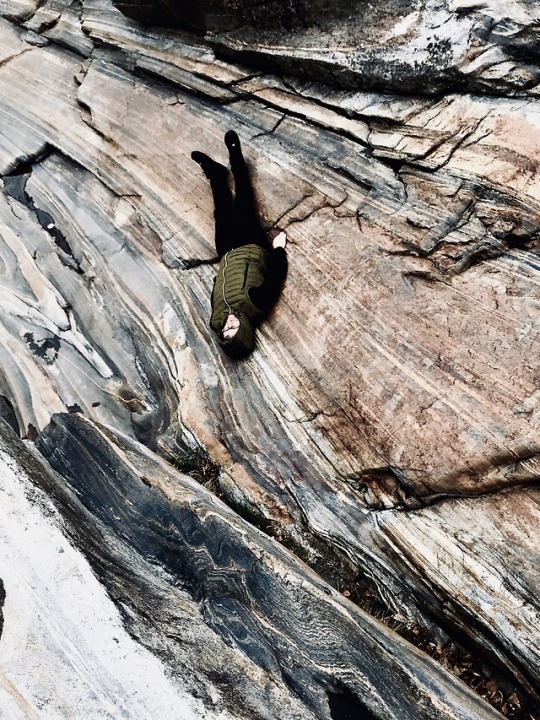
Fluid stone Lavertezzo
In the Valle Verzasca the village of Lavertezzo has become a popular tourist destination and the reason is clear. The view on the narrow, winding approach, which comprises of the church steeple, the formation and the beautiful arched stone bridge is an iconic snapshot, but for us, the real highlight is the beautiful, clear Verzasca River, which at low tide offers a spectacular vista on its colourful and beautifully eroded stone bed. The river appears to have imposed its fluid, organic and ever-flowing nature on the rocks. Though it’s bare stone, some of the river’s creations are surprisingly ergonomic forms, comfortable enough to take a break.
It is also possible to bathe in the river, without the fear of being swept away with the current. On a hot summer day its very a refreshing experience — otherwise the water is positively freezing. Finally, if you want to carry away some decent pictures without the omnipresent photobombers, the usual advice to visit later in the day applies here as well. You’ll have the added benefit of warm evening light which enhances the surprisingly rich colours of the stone.
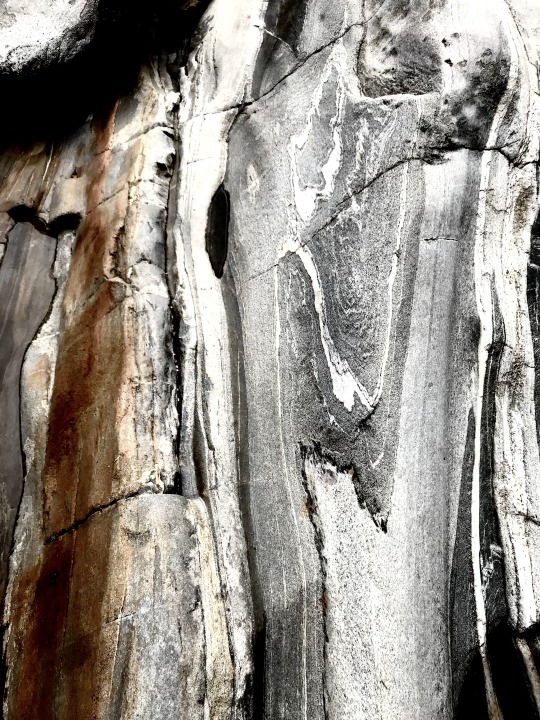
Whilst in the Verzasca valley, you should definitely not miss out on other points of interest. If you have the time, the impressive Verzasca dam at the entrance to the valley is worth casting a glance over. Notoriously filmed in a Golden Eye stunt, 007 himself can be seen leaping off the edge of this massive 220 metre wall of concrete. If you’re feeling adventurous, you can try the highest bungee jump yourself. For flatland-hikers, the trail along the river from Brione to Lavertezzo is also highly recommended. The small villages Corippo and Mergoscia are also worth a visit and finally, if you are looking for a more demanding hike, you can just crawl up the side of the valley and you will be rewarded with stunning views of Lago Maggiore and beyond.
1 note
·
View note
Photo
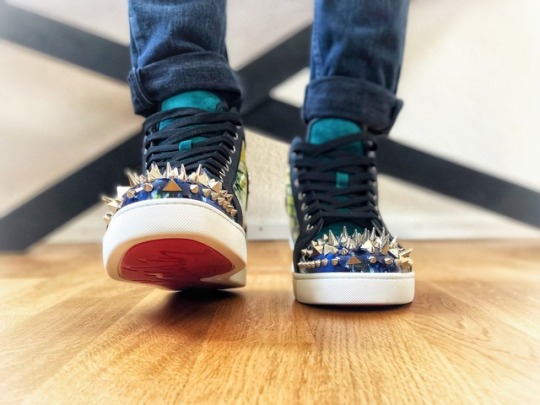
Lou Pik Pik Orlato Chistian Louboutin
“Exuding an Italian spirit where tradition and modernity fuse for Rococo flair, the iconic Louis Orlato high-top sneakers have the airs of a painting.”
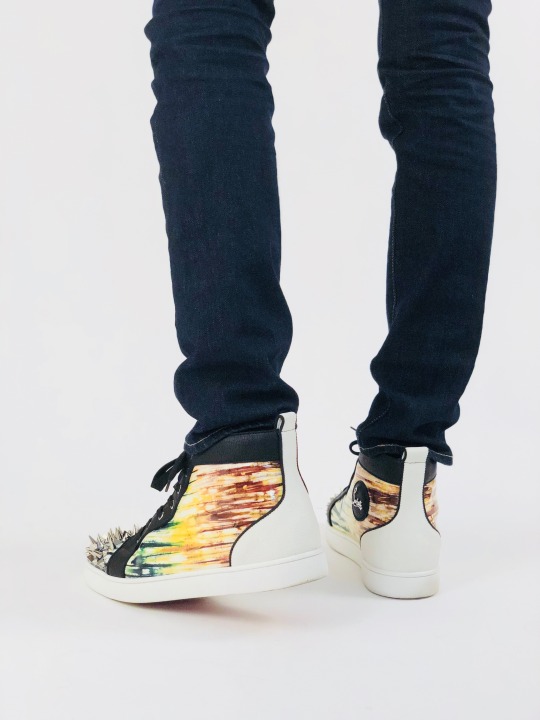
With a sort of bird of paradise or tropical forest patterned specchio leather at the toe and the outer quarters (the toe being covered in spikes), trimmed in black and white leather and a tongue finished in emerald green suede, the luxurious quality of the shoe is undeniable.
Designer, Christian Louboutin has in the past been quoted saying, “I hate the whole concept of comfort.” And even going as far as comparing comfort in a shoe to being in a bad relationship, or not really being in love… Obviously, he wasn’t talking about his sneakers, but it seems relevant to mention it, seeing as these are extraordinarily comfortable and I am certainly in love with them.
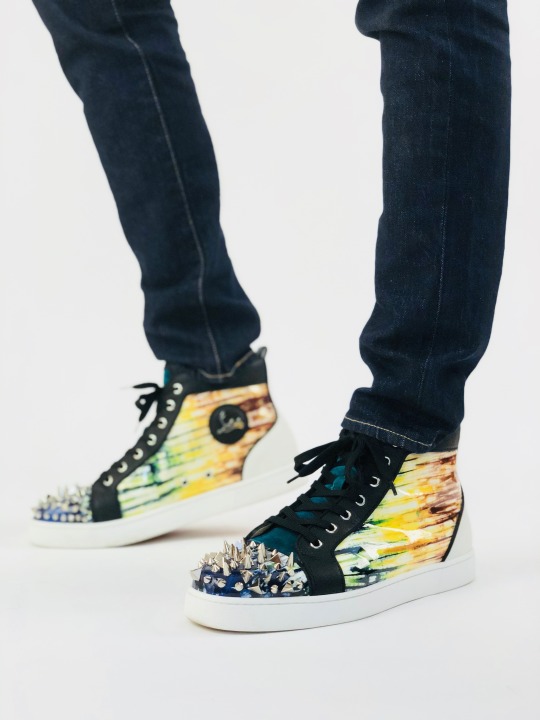
#Christian Louboutin#Louboutin Homme#Louboutin World#Pik Pik Orlato#Spikes#Red Soles#French#Paris#Sneakers#Trainers#Specchio Leather#Suede
0 notes
Photo

Aeroccino Nespresso
I still prefer to make my coffee manually and to my exacting specifications, but if I want to make a caffè latte or cappuccino (hot or cold), the Aeroccino system from Nespresso makes it so much easier.
It automatically heats and whips the milk into the most luxurious, frothy foam you’ve ever tasted. Just tap the button and let it work. There’s no vibration and only the slightest purr of the spiral foaming ring.
It can also be used to make a near perfect Matcha Green Tea latte without the whisk.
-Finn
#Nespresso#Aeroccino#Aeroccino 4#Coffee#Café#Caffè#Latte#Cappuccino#Matcha Green Tea Latte#Matcha#Bodum#Bialetti
0 notes
Photo
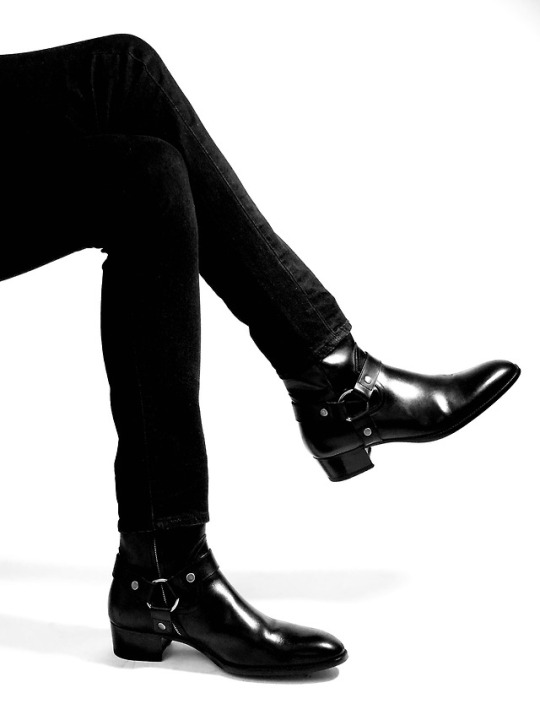
Leather Harness Boots (Wyatt) Saint Laurent
For those who could use the extra height without actually reaching for a pair of ladies heels, look to the French, or more specifically, Saint Laurent.
Elegant, stylish, and made for those men who aren’t afraid to make a statement, the chunky-heeled boots fit perfectly under a pair of slim jeans. Sure you can play it safe and wear them with a classic bootcut, and they’ll do the job easily, but these works of art beg to be seen.
The biker style boots from the iconic French house will certainly make you feel like the leader of the pack.
-Finn
6 notes
·
View notes
Photo
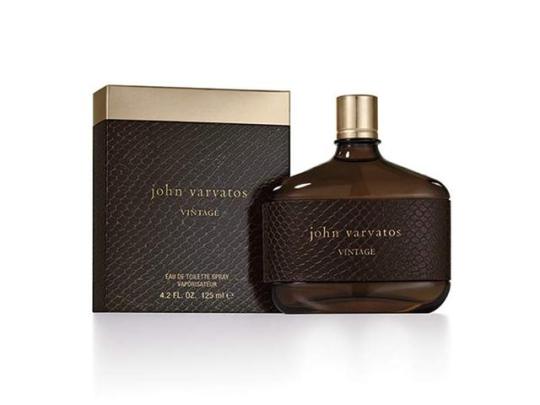
Vintage John Varvatos
No look is complete without a scent. My signature scent is Vintage, by John Varvatos. With base notes that include rare woods, suede and tobacco, it very much lives up to it’s name. It’s sensual and smooth, yet masculine and is the perfect accent to any elegant or casual look.
Rugged
Masculine
Spicy
Woodsy
Leathery
-Finn
0 notes
Photo


7 - Seven Minute Workout
I’m super lazy. There! I’ve said it. I’m lazy and at times rather unmotivated. I’m slender and tall and have always just sort of rested on that, but after a few sudden life changes (which were forced on me), I’d begun to let myself go a bit. one day while walking, I felt it. A jiggle. Yes, a jiggle around my mid-section and I realised that lazy and unmotivated wasn’t going to cut it anymore.
I started using 7, the seven minute workout app, and after having to force myself out of bed early enough to do it (for several weeks), that little jiggle is gone, thanks in no small part to my high metabolism, and I really feel more energetic and just more driven to start my days.
The first few days (or weeks) are hard for people like me, but once you’re over that hump, it doesn’t take much and 7 minutes really isn’t a big deal in the grand scheme of 24 hours. I’m not saying you’ll develop a rock hard and muscular body, but you can absolutely expect to feel and see the results of you workout.
For a bigger challenge, try extending the 7 minutes to 14, or more! What ever time you’re willing to devote to your physical and mental well-being will be much appreciated by your body.
-Finn
#7#Seven#Seven Minute Workout#iOS#Android#Google#Fitness#Health#Well-being#Healthy Body#Healthy Mind
0 notes
Photo


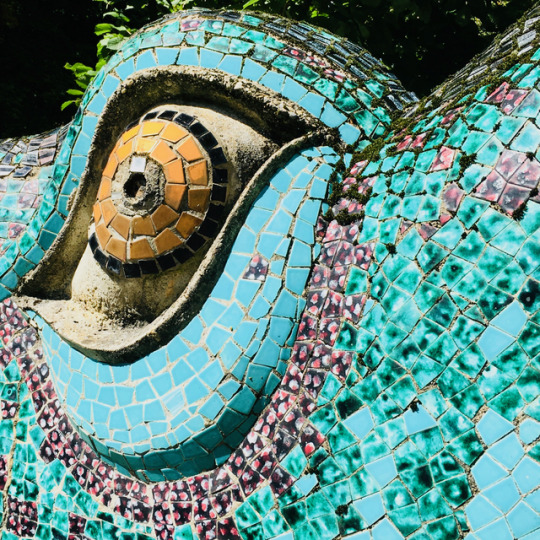
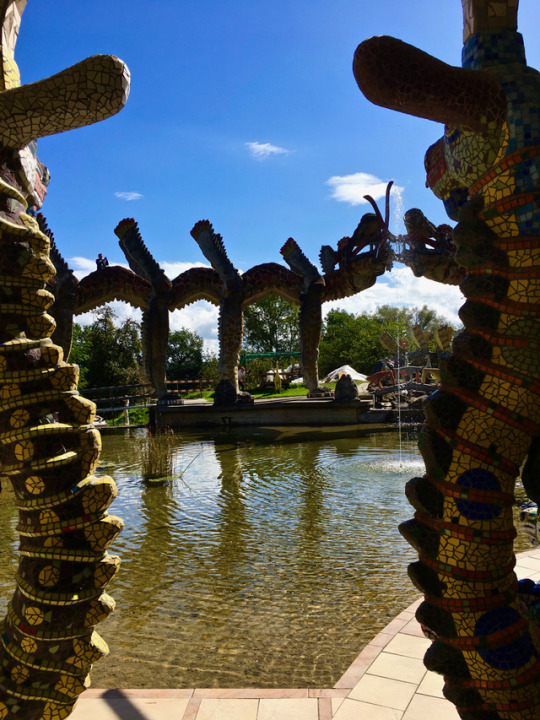
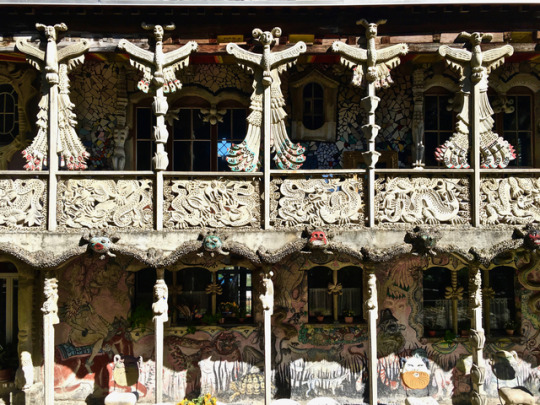
The “Swiss Gaudí”
Sculpture and architecture scenes are usually dominated by a few, or, sometimes even one, regional artist, giving a unique identity to a city. Europe’s tourist-mecca, Barcelona is one of the best examples. The architect, Antoni Gaudí shaped the city in many ways. His organic approach to architecture made him a sculptor, designer and soon, perhaps, even a saint (his canonisation being under consideration).
While Zurich is shaped by more diverse artistic influences, we have recently discovered a sort of “Swiss Gaudí” here. His name was Bruno Weber. He was much more a sculptor, and is probably far yet, from canonisation. His characteristic clay-toned figures, featuring some rather fanciful animals, are found in many nearby places. For instance, when approaching the summit of Zurich’s resident “mountain” the Uetliberg, one is greeted by what can only be described as “man-moose-giraffe” lamps with large glowing globes on the antlers, flanking either side of the path (in rather large scale).
The best opportunity to compare and contrast the parallels between Weber and Gaudí, is the home of the former, Bruno Weber Park, which is now open to the public.
It is filled with sculpted curiosities, large and small sculptures and a small (but not so simple) house. Whoever has seen Gaudí’s Park Güell cannot deny some the glaring, if not as fine, resemblances. Weber did not care about the limitations of his main building material — concrete. He moulded it into serpents which acted as a high passerelle around a water feature, unmountable tiny bridges and highly (over)detailed facades. This is also what seems to make restoration and upkeep of the property relatively tricky. The constant struggle is visible. And just like Gaudí, Weber decorated the surfaces with broken, colourful tiles. The park was a lifelong project for him that remained unfinished.
It doesn’t have the glory of Park Güell, but it is definitely worth a stroll when viewed as a local curiosity rather than a world-renowned architectural highlight.
#Bruno Weber#Uetliberg#Bruno Weber Park#Zürich#Suisse#Schweiz#Svizzera#Svizra#Switzerland#Dietikon#architecture#sculpture
1 note
·
View note
Photo
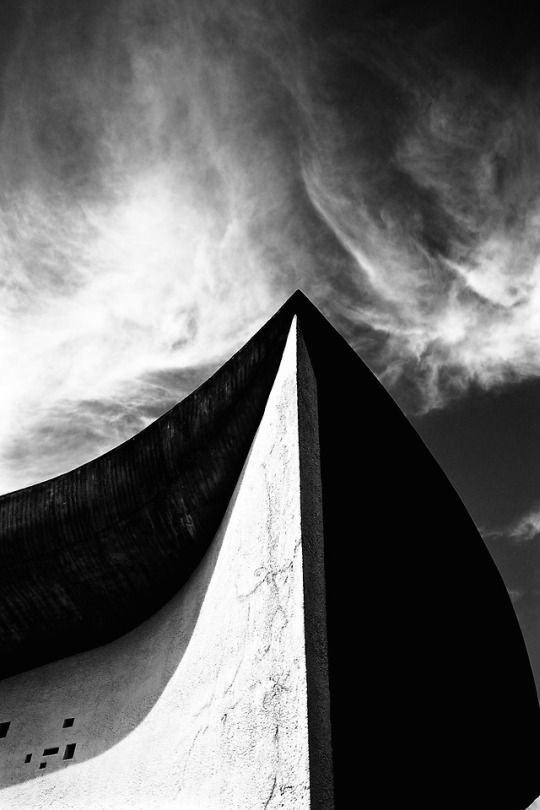
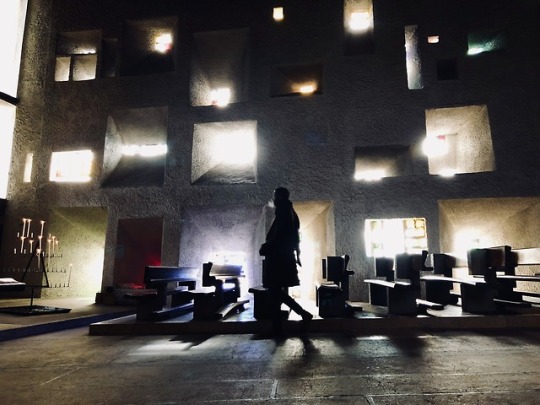
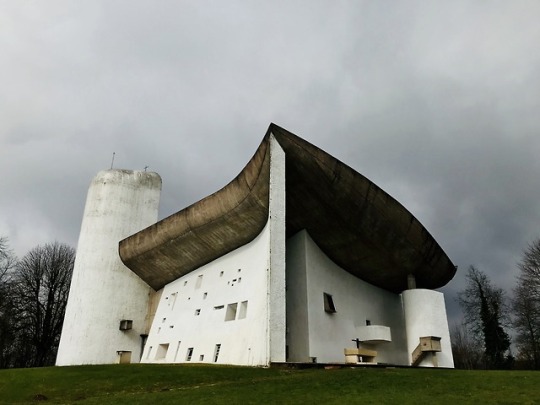
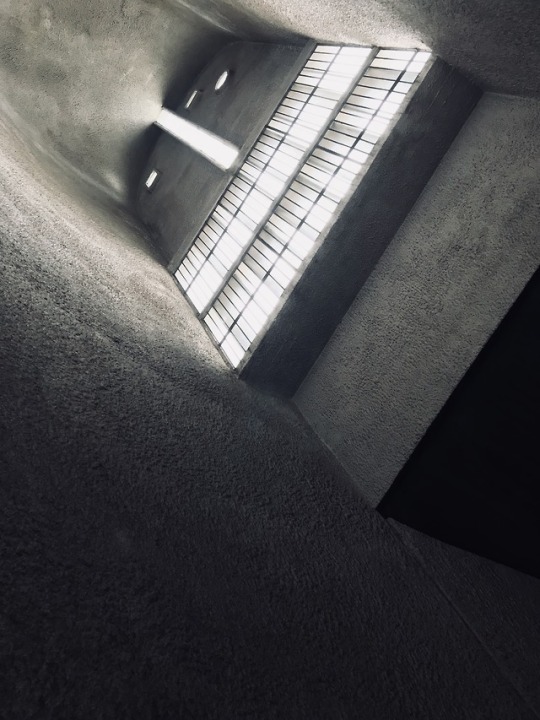
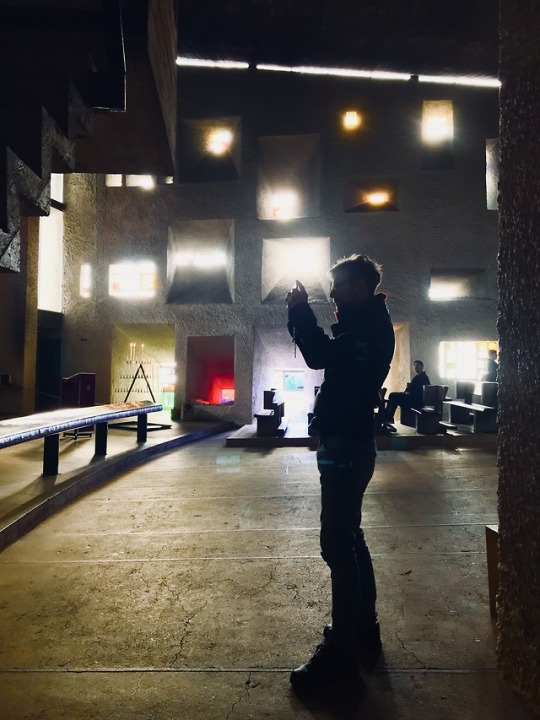
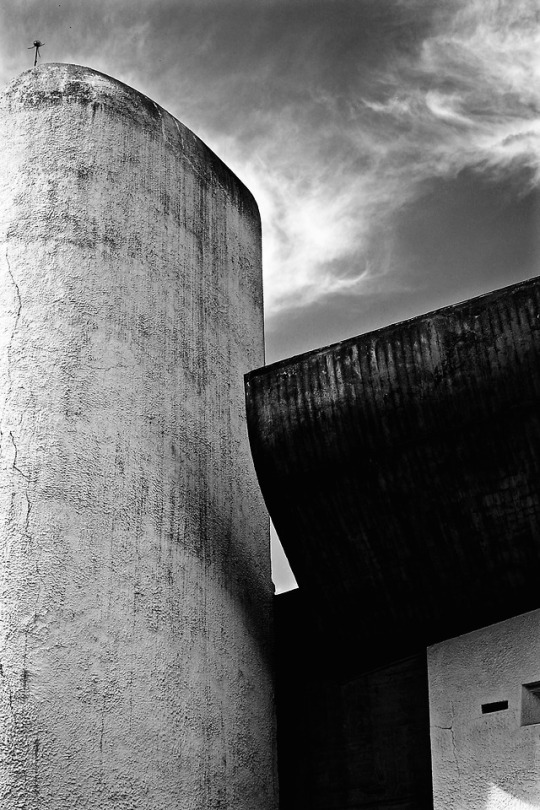


A pilgrimage to modern architecture
Chapelle Notre-Dame-du-Haut
Chapelle Notre-Dame-du-Haut is the product of complete architectural freedom and from any (and every) perspective, it’s difficult to believe that it is all one structure. That is the genius of the unique design by Charles-Édouard Jeanneret, better known by his moniker, Le Corbusier.
Upon approach to this small chapel on Bourlémont Hill, in Ronchamp you know immediately, that you’re in for something truly amazing.
On the main entry side, is a massive, curved wall of differently sized and shaped windows that appear in a sprawling, haphazard pattern like an obscure art project by a young child. There is, however, a method to this madness. Each window is centered and slanted at varying degrees to allow light to flow through at different angles. Also on this wall is a rather large, centre-hinged door which looks like a modern art canvas.
“Like a sail billowing in the windy currents on the hilltop”, the pointed, sloping roof of this impressive feat of architecture is supported by columns, hidden within the thick, white concrete walls. It appears to float above the main structure, and is in fact separate, with the gap filled by clerestory windows, which allows natural light to flow in.
Visible from the inside, is the light coming through the break between the roof and the walls, but also, the light coming through the aforementioned windows of the south wall. Only now, you’re treated to some colour. This puts the windows into context and you realise just how effective the pattern is.
There are no light fixtures. The small interior, with benches made of African wood, thick walls and shallow steps of concrete as well as more traditional confessional booths of wood, is lit naturally though the visible windows, and the more obscured windows of the domed towers.
Also on the grounds are a small, unassuming campanile by Jean Prouvé to the north, la Porterie (entrance pavilion) and the Sainte-Claire monastery by Renzo Piano, tucked into Bourlémont to the south and north west respectively, and a small stone pyramid, erected for the liberators of Ronchamp as a memorial using stone from the original 4th Century pilgrimage chapel which was destroyed during the second World War.
#Chapelle Notre Dame du Haut#Le Corbusier#Jena Prouvé#Renzo Piano#Ronchamp#France#Bourlemont#Franche-Comté#Ballons des Vosges#UNESCO#World Heritage Site#Modernism#Architecture#Roman Catholic#Pilgrimage Chapel#primitive#sculptural#post-modern#expressionist
2 notes
·
View notes
Photo










Ten plates...
What may seem excessive in the western world is rather commonplace for high-end dinners in Japan: ten courses or more, each assembled with the greatest attention to detail. Let it be said that such a thing is also in stark contrast to the everyday eating habits in Japan, where people gulp down a pot of Ramen noodle soup in no time.
We’d recommend a small, quaint, and romantic restaurant, Gion Nanba, for a relaxed and intimate, Japanese dining experience. The challenge is to actually find this jewel, which hides itself in a small alley off a main road in the Gion district. Once you’ve found it, you’ll enjoy great service and a very rich and interesting dining experience. Be sure that you have enough time and enough of an appetite, as our dinner lasted about two and a half hours (and two desserts).
We received detailed explanations (in English) of everything set in front of us and a bit of a comedy act as our waitress stumbled on words and giggled ever so girlishly (and charmingly) at her errors.
Priced at approximately 10′000 Yen for 10 courses, it’s rather reasonable, considering that this restaurant brandishes a Michelin star.
You’ll need a map, a compass and a clear starry night to find this place, but it’s well worth it.
PS. Don’t touch the Geishas.
#Japan#Kyoto#Gion#Japon#Giappone#Michelin Star#日本#京都#Gion Nanba#romantic#dinner#holidays#vacanze#vacances#Ferien#romantisch#romantico#romantique
0 notes
Photo







Paris’ morbid underground
The interesting part of city tourism usually happens above the ground: in museums, parks, restaurants, and lookout sites. However, one of the most curious, and not-to-be-missed sights of Paris is subterranean.
The catacombs are a network of tunnels which belonged to twelfth century limestone mines underneath much of the southern part of the inner city. While that might not sound so exciting in itself, large parts of these caverns have been filled from floor to ceiling with piles and piles of bones and skulls. This giant ossuary was created towards the end of the 18th century due to of a sheer overflow of the city’s cemeteries.
The remains of an estimated 6 million people can be found here; about ten times the entire population of Paris at the time! It is the oddest sensation to walk through long corridors of wall to wall human skeletal remains. Not only is it plainly shocking, but you will certainly find it a creepy and spine-chilling encounter, which, unlike the scripted scariness of horror films, is fully real.
You can touch the bones.
Everything one sees during the visit is surprisingly clean and orderly, even the air is rather fresh. Some of the bones are piled up very neatly, which adds a grotesque twist to the setting. Imagine skulls shaped into patterns, crosses — and even hearts!
It certainly begs the question of which is more creepy: That someone decided to make this an actual exhibition (after some public demand, btw), or that we, as consumers, actually pay to see it...
As with many sights in Paris, make sure to plan for the sometimes immense queue, or — better — buy tickets in advance, online.
#Paris#France#Parigi#Francia#Île de France#Frankreich#ossuary#catacombs#catacombes#Katakomben#catacombe#Barrière d'Enfer#Place Denfert - Rochereau#Rive Gauche#Finn and Grey#underground#sous-sol#sottosuolo#untergrund
0 notes
Video
tumblr


Pinnacle island
Magical is the word that comes to mind when you first see it. It looks like something straight out of a fantasy novel. You almost can’t believe what you’re seeing and yet, there it is, rising out of the bay like, the peak of a mountain above the clouds. This tidal island has withstood the test of time and defied its ravages, storms and would-be assailants. And as opposed to coming from some fantasy novel, it has inspired many a writer and artist. It was, for example, inspiration for the iconic city of Minas Tirith from The Lord of the Rings film series.
Le Mont Saint-Michel is a unique and astonishing place on the French Atlantic coast, some four hour ride west of Paris. The massive rock has been decorated with buildings and fortifications to its extremities. An abbey, supported by an impressive system of crypts and pillars crowns the island. It has, however, never been a religious center, but one of power and imprisonment. Fifty inhabitants live on the Mont today, but no less than three million tourists come to see it every year.
We couldn’t help but go twice: Once at night, when the mighty walls close in around you like a heavy coat, and the mountain looks like a mirage before the night sky, and again at daybreak as the first light reaches the abbey and morning mist still surrounds the base of mountain.
Nicole and Pierre will receive you warmly at “L’Orée du Mont”, if you’d like to stay overnight. It’s a cozy and charming B&B which we highly recommend.
#Le Mont St. Michel#Baie du Mont St Michel#Bretagne#Brittany#Normandie#Îles Anglo-Normandes#Manche#Atlantique#Atlantic#Channel Islands#La Manche#English Channel#La Manica#Ärmelkanal#Atlantik#Atlantico#L'Orée du Mont#Pontorson#France#Frankreich#Francia#UNESCO#World Heritage Site
0 notes
Photo




Mon Cher Chenonceau
A renowned Château of the Loire Valley, Chenonceau feels much less palatial than most of the others. It feels more like a home. A home, of course, with a bridge (fitted with an upper and lower gallery) sprawled across the River Cher.
As you approach the seemingly compact castle, you're greeted to the left by the garden of Diane de Poitiers and the garden of Caterina de' Medici to the right. Apart from sharing a bloodline (and the King of France), the two shared a love of this "Beau Château."
Venture into either of the two gardens and you're treated to, not only immaculately manicured lawns, luscious blooms and great topiaries, but also to a much advantageous view on the flanks of the castle and it's gallery bridge. It's beautiful stone arches and posts plunging into the Cher.
Rent a rowboat and marvel at the splendour from every possible angle.
#Chenonceaux#Château de Chenonceau#Loire Valley#Loire et Cher#France#Loira#Castello#Castle#Schloss#Château#Châteaux de la Loire#Francia#Frankreich#Cher#Centre Val de Loire#Indre et Loire#River#Rive#Fiume#Fluss#Valle della Loira#Val de Loire
1 note
·
View note
Photo





Fun times at Gaudíland
A cross between Candyland, a gingerbread house and the skeleton of some fantastical creature, Park Güell is the culmination of whimsical imagination and architectural genius.
The first impression will probably be, "what on earth did I just walk into?" But as you immerse yourself and start to focus on the details and the used materials and techniques and the colours, and begin to appreciate the amount of creativity and imagination that went into its conception, you'll begin to realise that you've walked into something quite singularly marvellous.
Originally meant to be a living community, Count Eusebi Güell commissioned Antoni Gaudí (who had already begun carving Barcelona with his uniquely organic and monumental creations) to realise this ambitious project. Together they conceived a park within a natural park, full of beautiful, modern homes with all the comforts and technologies of the time. But as the original plan failed, the park was opened to the public some twelve years later and has continued on as what we’ve now come to see.
The view from Carmel Hill is spectacular and from it, you’ll be able to see, in the distance, another (and probably most famous) of Gaudí's imaginings-come-to-life, The Basilica and Explatory Church of the Holy Family, more commonly known as, Sagrada Família.
By the way, avoid being lumped in with the great unwashed and buy the tickets online people!
#Barcelona#Barcellona#Barcelone#Espanya#españa#Espagne#Spagna#cataluña#Catalonia#Catalunya#antoni gaudí#Eusebi Güelll#Parc Güell#Monumental Zone#UNESCO#Architecture#Spanien
1 note
·
View note
Photo





A grain of sand
For look! Within my hollow hand, While round the earth careens, I hold a single grain of sand And wonder what it means. Ah! If I had the eyes to see, And brain to understand, I think Life's mystery might be Solved in this grain of sand. Robert W Service
This poem may help to make a visit to the largest sand pile that Europe has to offer meaningful. But how do you make it fun? We’ll tell you! Drive out to the French Atlantic Coast, about an hour from Bordeaux and you’ll find the Dune of Pilat. But don’t expect to be on your own on this giant: With over a million visitors per year, the dune along with it’s facilities, shops, and restaurants is not exactly a lonely place. However, if you are willing to walk a bit on the dune, you will quickly get away from the masses. There’s enough sand for everyone.
So here is what you do: Switch on the live photo/motion stills function or make videos. Take a selfie running across the dune (perhaps with some back light). Make a spray of sand with your feet. Run down the steep parts of the dune in huge strides. Pitch yourself on to the heap! Jump around and make a complete fool of yourself.
(If you are in for a bit of a workout: try running uphill. That’ll get the blood pumping!)
Treat the inner kid that always desired a bigger pile of sand, to the biggest one imaginable! Just make sure to bring a snack. You’ll build up an appetite after all the excitement. Afterwards, you can cool down in the sea...
#Dune du Pilat#dune du pyla#Dune of Pilat#French Atlantic Coast#Basin of Arcachon#Bassin d'Arcachon#Arcachon Bay#La Teste de Buch#Aquitaine#landes de gascogne#Côte d'Argent#Dune#Sand#Sable#Sabbia#Duna di Pilat#Gironda#Bacino di Arcachon#Lande di Guascogna#Atlantic#Atlantique#Atlantico#Oceano#Océan#Ozean#Ocean
1 note
·
View note
Photo




House of bones
Barcelona is full of beauty … and tourists. Now, there is no point in blaming anyone, since we’re touristing as well, but the beauty is much more easily enjoyed with less people around. One way to do that is to look out for places that are open late and to go when others are fighting for a table in the restaurant that TripAdvisor sent them to. We found Casa Batlló or, Casa dels ossos, as the locals call it, to be a perfect remedy. In summer, it offers after-hours access (known as Magic Nights) to a limited number of visitors (prebook on the webpage!). The entrance fee includes drinks and music in a romantic rooftop setting.
Casa Batlló is a great example of Antonio Gaudí’s eccentric Art Nouveau architecture, which is the major backbone of Barcelona’s tourist attractions. In this grand townhouse, which Gaudí did not build, but rather drastically transformed, you will find many aesthetic surprises. The one thing you won’t find are straight lines — everything is built in a flowing, organic and skeletal style. Water and the ocean are prominent themes throughout the building, referenced in the swirl-like ceiling of the living room and in the blue tiles of the light well and staircase, which become ever darker the closer one gets to the sky. Unique shapes embrace the visitor throughout the house. You’ll come back full of inspiration on how you can transform your own home, or anything in your life, really, without the need for rebuilding it!
#Barcelona#Catalunya#Espanya#españa#Spain#Spagna#Espagne#Spanien#Barcellona#Catalonia#cataluña#Barcelone#Casa Batlló#Casa dels Ossos#Antonio Gaudi#gaudí#architecture#bones#huesos#ossatura#des os
2 notes
·
View notes
Photo







An amusement park for design lovers
Frank Gehry, Herzog-de Meuron, Zaha Hadid — architectural giants whose buildings deserve attention no matter what purpose they serve. Now imagine there was a place where you could see works by all of them in one spot. That sounds like an overdose of modern architecture, but nestled in Weil am Rhein, buildings by all of them are arranged in peaceful coexistence, forming the campus and museums of Vitra. Ensconced amidst green hills and fields, the Vitra desgin museum, is a grand showcase of contemporary Vitra products, a museum of furniture design and more. The beauty of the Vitra’s furniture adds to that of the architecture, creating an exciting swirl into which the visitor is drawn.
The whole experience is like a cross between a visit to an upscale IKEA market, when it comes to the exemplary Vitra-furnished rooms, and an amusement park for people with allegedly good taste...
In any case, we recommend you spend (at least) half a day. Enjoy the tasty food offered in the cafeterias, and make sure you have good weather to explore the outdoor areas as well.
As a remark on the giants: They have not always been gigantic. In fact, Zaha Hadid was commissioned to build something as mundane as a fire station for Vitra and it was her first building ever. For this purpose, the building is too big of a gesture. Vitra must also have come to the realisation, since soon after the building was finished, the company dispatched its fire brigade and ever since, the building plays host to exhibitions and events, as if it were conceived for exactly that...
#Vitra#Vitra Museum#Design#Architecture#Furniture#Möbeldesign#Möbel#meubles#Mobilia#Weil am Rhein#Eames#Prouvé#Panton#Hadid#Gehry#Germania#Allemagne#Deutschland#Germany
2 notes
·
View notes